
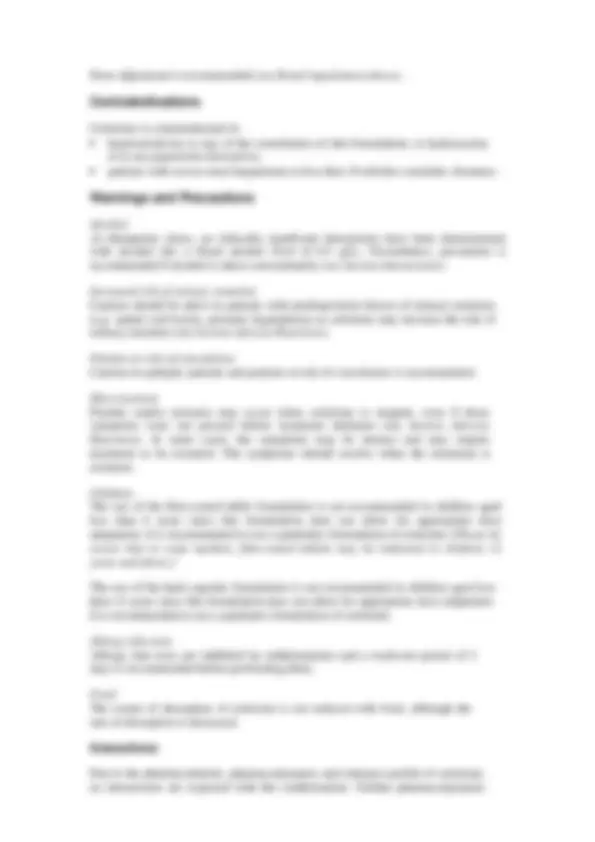
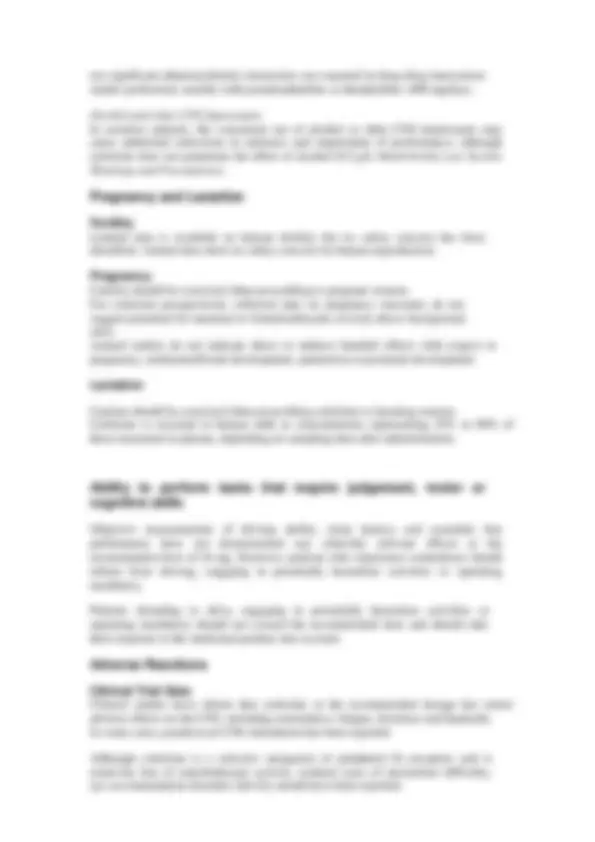
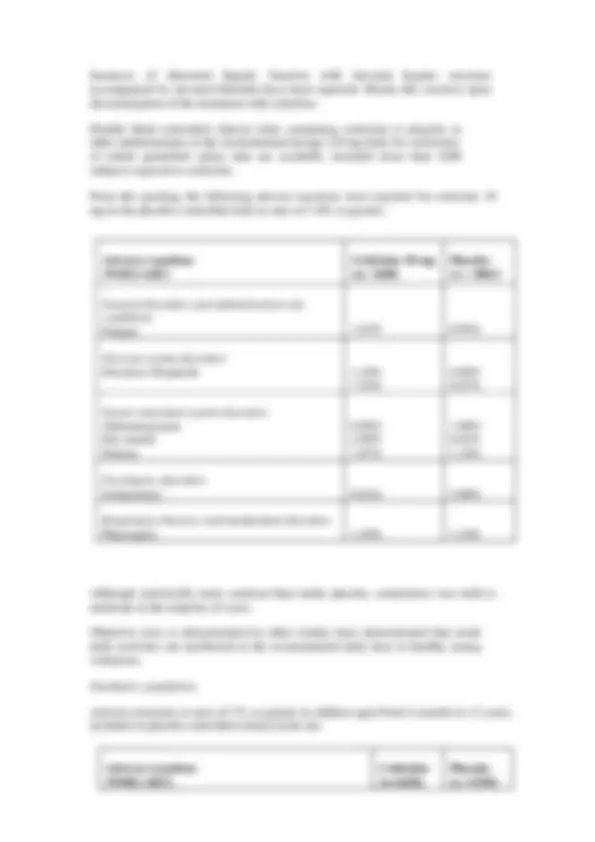
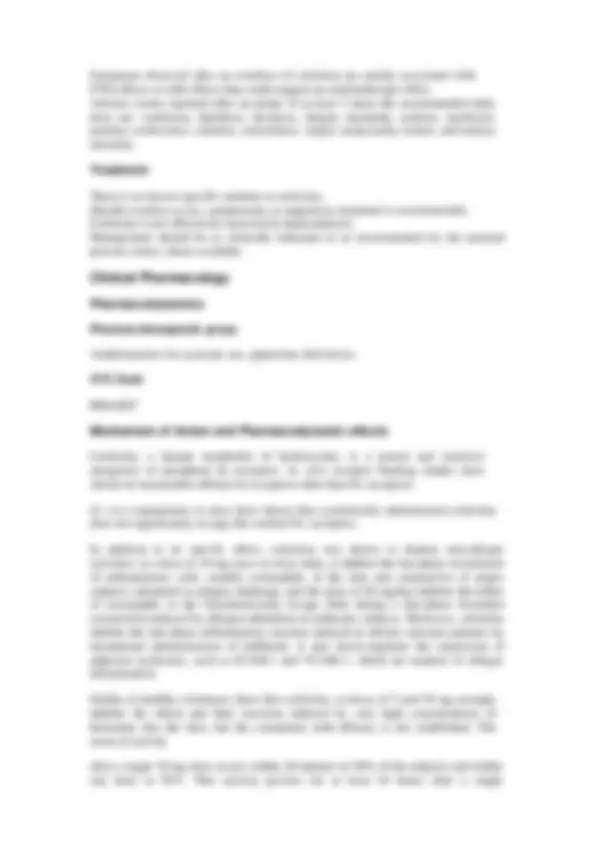
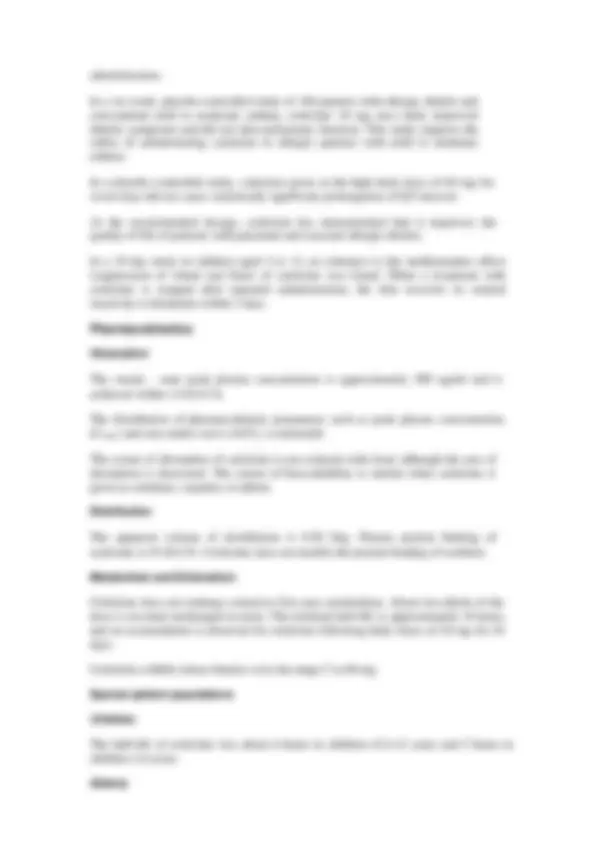



Study with the several resources on Docsity

Earn points by helping other students or get them with a premium plan


Prepare for your exams
Study with the several resources on Docsity

Earn points to download
Earn points by helping other students or get them with a premium plan
Community
Ask the community for help and clear up your study doubts
Discover the best universities in your country according to Docsity users
Free resources
Download our free guides on studying techniques, anxiety management strategies, and thesis advice from Docsity tutors
Information on the pharmaceutical form, composition, dosage adjustments, warnings, and adverse reactions of Cetirizine dihydrochloride, a medication used to treat allergies and related conditions. It covers topics such as renal and hepatic impairment, interactions with other substances, and pregnancy and lactation safety.
Typology: Lecture notes
1 / 11

This page cannot be seen from the preview
Don't miss anything!







Cetirizine dihydrochloride, 10 mg, film-coated tablet
Cetirizine dihydrochloride, 10 mg, film-coated tablet Each film-coated tablet contains 10 mg of cetirizine dihydrochloride.
Microcrystalline cellulose, Lactose monohydrate, Colloidal anhydrous silica, Magnesium stearate, Opadry Y-1-7000 which consists of, Hydroxypropylmethylcellulose (E464), Titanium dioxide (E 171), Macrogol 400.
Cetirizine dihydrochloride, 10 mg, film-coated tablet
White, oblong, film-coated tablet, with a bisect line and Y-Y logo.
For the relief of:
The tablets need to be swallowed with a glass of liquid.
Route of Administration
For oral use.
Adults
10 mg (1 tablet) once daily.
A 5 mg starting dose (half of the tablet) may be proposed if this leads to satisfactory control of the symptoms.
Children
Children aged from 2 to 6 years Not indicated.
Children aged from 6 to 12 years 5 mg (half of the tablet) twice daily.
Children over 12 years of age 10 mg (1 tablet) once daily.
Elderly
Data does not suggest that the dose needs to be reduced in elderly subjects provided that the renal function is normal.
Renal impairment
Since cetirizine is mainly excreted via renal route, in cases no alternative treatment can be used, the dosing intervals must be individualised according to renal function.
Refer to the following table and adjust the dose as indicated. To use this dosing table, an estimate of the patient’s creatinine clearance (CLcr) in ml/min is needed. The CLcr (ml/min) may be estimated from serum creatinine (mg/dl) determination using the following formula:
CLcr=
[140−𝑎𝑎𝑎𝑎𝑎𝑎(𝑦𝑦𝑎𝑎𝑎𝑎𝑦𝑦𝑦𝑦)] 𝑥𝑥 𝑤𝑤𝑎𝑎𝑤𝑤𝑎𝑎ℎ𝑡𝑡(𝑘𝑘𝑎𝑎) 72 𝑥𝑥 𝑦𝑦𝑎𝑎𝑦𝑦𝑠𝑠𝑠𝑠 𝑐𝑐𝑦𝑦𝑎𝑎𝑎𝑎𝑡𝑡𝑤𝑤𝑐𝑐𝑤𝑤𝑐𝑐𝑎𝑎(𝑠𝑠𝑎𝑎/𝑑𝑑𝑑𝑑)^ (𝑥𝑥^ 0.85^ 𝑓𝑓𝑓𝑓𝑓𝑓^ 𝑤𝑤𝑓𝑓𝑤𝑤𝑤𝑤𝑤𝑤)
Dosing adjustments for adult patients with impaired renal function
Group Creatinine clearance (ml/min)
Dosage and frequency
Normal ≥ 80 10 mg once daily
Mild 50 – 79 10 mg once daily
Moderate 30 – 49 5 mg once daily
Severe < 30 5 mg once every 2 days
End-stage renal disease - Patients undergoing dialysis
< 10 Contraindicated
In paediatric patients suffering from renal impairment, the dose will have to be adjusted on an individual basis taking into account the renal clearance, age and body weight of the patient.
Hepatic impairment
No dose adjustment is needed in patients with solely hepatic impairment.
Patients with hepatic impairment and renal impairment
nor significant pharmacokinetic interaction was reported in drug-drug interactions studies performed, notably with pseudoephedrine or theophylline (400 mg/day).
Alcohol and other CNS depressants In sensitive patients, the concurrent use of alcohol or other CNS depressants may cause additional reductions in alertness and impairment of performance, although cetirizine does not potentiate the effect of alcohol (0.5 g/L blood levels) ( see Section Warnings and Precautions ).
Fertility Limited data is available on human fertility but no safety concern has been identified. Animal data show no safety concern for human reproduction.
Pregnancy Caution should be exercised when prescribing to pregnant women. For cetirizine prospectively collected data on pregnancy outcomes do not suggest potential for maternal or foetal/embryonic toxicity above background rates. Animal studies do not indicate direct or indirect harmful effects with respect to pregnancy, embryonal/foetal development, parturition or postnatal development.
Lactation
Caution should be exercised when prescribing cetirizine to lactating women. Cetirizine is excreted in human milk at concentrations representing 25% to 90% of those measured in plasma, depending on sampling time after administration.
Objective measurements of driving ability, sleep latency and assembly line performance have not demonstrated any clinically relevant effects at the recommended dose of 10 mg. However, patients who experience somnolence should refrain from driving, engaging in potentially hazardous activities or operating machinery.
Patients intending to drive, engaging in potentially hazardous activities or operating machinery should not exceed the recommended dose and should take their response to the medicinal product into account.
Clinical Trial Data Clinical studies have shown that cetirizine at the recommended dosage has minor adverse effects on the CNS, including somnolence, fatigue, dizziness and headache. In some cases, paradoxical CNS stimulation has been reported.
Although cetirizine is a selective antagonist of peripheral H 1 -receptors and is relatively free of anticholinergic activity, isolated cases of micturition difficulty, eye accommodation disorders and dry mouth have been reported.
Instances of abnormal hepatic function with elevated hepatic enzymes accompanied by elevated bilirubin have been reported. Mostly this resolves upon discontinuation of the treatment with cetirizine.
Double blind controlled clinical trials comparing cetirizine to placebo or other antihistamines at the recommended dosage (10 mg daily for cetirizine), of which quantified safety data are available, included more than 3200 subjects exposed to cetirizine.
From this pooling, the following adverse reactions were reported for cetirizine 10 mg in the placebo-controlled trials at rates of 1.0% or greater:
Adverse reactions (WHO-ART)
Cetirizine 10 mg (n= 3260)
Placebo (n = 3061)
General disorders and administration site conditions Fatigue 1.63%^ 0.95%
Nervous system disorders Dizziness Headache 1.10% 7.42%
Gastro-intestinal system disorders Abdominal pain Dry mouth Nausea
Psychiatric disorders Somnolence 9.63% 5.00%
Respiratory thoracic and mediastinal disorders Pharyngitis 1.29% 1.34%
Although statistically more common than under placebo, somnolence was mild to moderate in the majority of cases.
Objective tests as demonstrated by other studies have demonstrated that usual daily activities are unaffected at the recommended daily dose in healthy young volunteers.
Paediatric population
Adverse reactions at rates of 1% or greater in children aged from 6 months to 12 years, included in placebo-controlled clinical trials are:
Adverse reactions (WHO-ART)
Cetirizine (n=1656)
Placebo (n =1294)
Not known : amnesia, memory impairment
Eye disorders Very rare : accommodation disorder, blurred vision, oculogyration
Ear and labyrinth disorders Not known: vertigo
Cardiac disorders Rare : tachycardia
Gastrointestinal disorders Uncommon: diarrhoea
Hepatobiliary disorders Rare: hepatic function abnormal (transaminases increased, blood bilirubin increased, blood alkaline phosphatase increased, gamma-glutamyl transferase increased) Not known: hepatitis
Skin and subcutaneous tissue disorders Uncommon : pruritus, rash Rare: urticaria Very rare : angioedema, fixed drug eruption Not known: acute generalized exanthematous pustulosis (AGEP)
Musculoskeletal and connective tissue disorders Not known: arthralgia
Renal and urinary disorders Very rare : dysuria, enuresis Not known: urinary retention (see Section Warnings and Precautions)
General disorders and administration site conditions Uncommon: asthenia, malaise Rare: oedema
Investigations Rare: weight increased.
Skin reactions occuring after discontinuation of cetirizine
After discontinuation of cetirizine, pruritus (intense itching) and/or urticaria have been reported (see Section Warnings and Precautions).
Symptoms and signs
Symptoms observed after an overdose of cetirizine are mainly associated with CNS effects or with effects that could suggest an anticholinergic effect. Adverse events reported after an intake of at least 5 times the recommended daily dose are: confusion, diarrhoea, dizziness, fatigue, headache, malaise, mydriasis, pruritus, restlessness, sedation, somnolence, stupor, tachycardia, tremor, and urinary retention.
Treatment
There is no known specific antidote to cetirizine. Should overdose occur, symptomatic or supportive treatment is recommended. Cetirizine is not effectively removed by haemodialysis. Management should be as clinically indicated or as recommended by the national poisons centre, where available.
Pharmacodynamics
Pharmacotherapeutic group
Antihistamines for systemic use, piperazine derivatives
ATC Code
R06AE
Mechanism of Action and Pharmacodynamic effects
Cetirizine, a human metabolite of hydroxyzine, is a potent and selective antagonist of peripheral H 1 -receptors. In vitro receptor binding studies have shown no measurable affinity for receptors other than H 1 -receptors.
Ex vivo experiments in mice have shown that systemically administered cetirizine does not significantly occupy the cerebral H 1 -receptors.
In addition to its anti-H 1 effect, cetirizine was shown to display anti-allergic activities: at a dose of 10 mg once or twice daily, it inhibits the late phase recruitment of inflammatory cells, notably eosinophils, in the skin and conjunctiva of atopic subjects submitted to antigen challenge, and the dose of 30 mg/day inhibits the influx of eosinophils in the bronchoalveolar lavage fluid during a late-phase bronchial constriction induced by allergen inhalation in asthmatic subjects. Moreover, cetirizine inhibits the late-phase inflammatory reaction induced in chronic urticaria patients by intradermal administration of kallikrein. It also down-regulates the expression of adhesion molecules, such as ICAM-1 and VCAM-1, which are markers of allergic inflammation.
Studies in healthy volunteers show that cetirizine, at doses of 5 and 10 mg strongly inhibits the wheal and flare reactions induced by very high concentrations of histamine into the skin, but the correlation with efficacy is not established. The onset of activity
after a single 10 mg dose occurs within 20 minutes in 50% of the subjects and within one hour in 95%. This activity persists for at least 24 hours after a single
Following a single 10 mg oral dose, the half-life increased by about 50% and clearance decreased by 40% in 16 elderly subjects compared to the younger subjects. The decrease in cetirizine clearance in these elderly volunteers appeared to be related to their decreased renal function.
Renal impairment
The pharmacokinetics of the drug was similar in patients with mild impairment (creatinine clearance higher than 40 ml/min) and healthy volunteers. Patients with moderate renal impairment had a 3-fold increase in half-life and 70% decrease in clearance compared to healthy volunteers.
Patients on haemodialysis (creatinine clearance less than 7 ml/min) given a single oral 10 mg dose of cetirizine had a 3-fold increase in half-life and a 70% decrease in clearance compared to normal. Cetirizine was poorly cleared by haemodialysis. Dosing adjustment is necessary in patients with moderate or severe renal impairment.
Hepatic impairment
Patients with chronic liver diseases (hepatocellular, cholestatic, and biliary cirrhosis) given 10 or 20 mg of cetirizine as a single dose had a 50% increase in half-life along with a 40% decrease in clearance compared to healthy subjects.
Dosing adjustment is only necessary in hepatically impaired patients if concomitant renal impairment is present.
Non-clinical data reveal no special hazard for humans based on conventional studies of safety pharmacology, repeated dose toxicity, genotoxicity, carcinogenic potential, toxicity to reproduction.
Please refer to the packaging.
Box/ 1 blister/ 10 tablets
There are no relevant data available.
There are no special requirements for use or handling of this product.
UCB Farchim S.A., Z.I. de Planchy,
Chemin de Croix-Blanche 10, 1630 Bulle, Switzerland
Version date: 20 April 2018